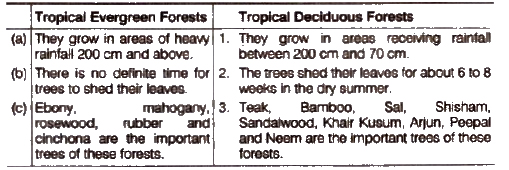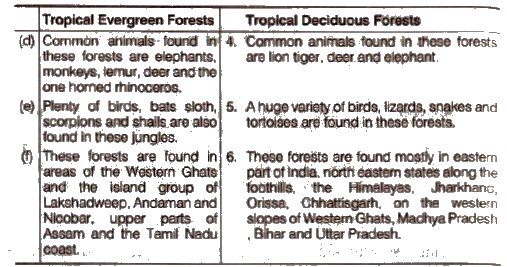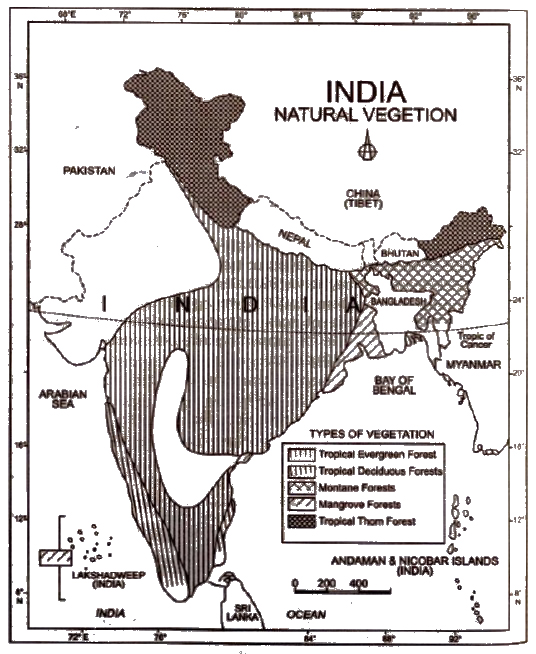
nature vegetation & wildlife ncert solutions for class 9 download pdf, wild animal, wild animals, wild animals information, south africa animals, national park animals, animals in wildlife sanctuaries , ncert solutions, chapter 12,chapter 12ncert solutions, ncert solutions, ncert solutions for class 9 social science, class 9 social science ncert solutions, ncert solutions for class 9, ncert class 9 social science, class 9 social science, class 9 social science solution, ncert solutions class 9, class 9 social science , ncert class 9, class 9 social science chapter 12,chapter 12 ncert solutions
Problem 1. Choose the right Solution from the four alternatives given below
(i) To which one of the following types of vegetation does rubber belong to ?
(a) Tundra
(b) Tidal
(c) Himalayan
(d) Tropical Evergreen
Solution : (d)
(ii) Cinchona trees are found in the areas of rainfall more than
(a) 100 cm
(b) 50 cm
(c) 70 cm
(d) less than 50 cm
Solution : (a)
(iii) In which of the following states is the Simlipal bioReserve located ?
(a) Punjab
(b) Orissa
(c) Delhi
(d) west Bengal
Solution : (b)
(iv) Which one of the following bioreserves of India is not included in the world network of bioreserve?
(a) Manas
(b) Nilgiri
(c) Gulf of Mannar
(d) Nanda Devi
Solution : (a)
Problem 2. anwser the following questions briefly
Define an ecosystem.
Solution : All the plants and animals in an area are interdependent and interrelated to each other in their physical environment, thus forming an ecosystem. Human beings are also an integral part of the ecosystem. They utilise the vegetation and wild life.
What factors are responsible for the distribution of plants and animals in India?
Solution : The factors responsible for the distribution of plants (flora) and animals (fauna) in India are
(a) Relief factors
Land
oil
(b) Climate
Temperature
Precipitation
Photoperiod (sunlight)
(iii) What is a bioreserve? Give two examples
Solution : A bioreserve is an area in which the flora and fauna of the given country is protected and there are certain researches which are done on them. It is an area containing a wildlife preserve bordered by a buffer zone in which more frequent use is permitted to the public, established as a way of integrating habitat conservation with the interests of the local community.
Examples are Rajaji in Uttarakhand and Simlipal in Orissa.
(iv) Name two animals having habitat in tropical and montane type of vegetation.
Solution : Animals found in Tropical forests are lion. tiger. pig, deer and elephant.
Animals found in Montane forests are Kashmir stag, spotted deer, wild sheep, jack rabbit, Tibetan antelope, yak, snow leopard, squirrels. shaggy horn wild ibex. bear and rare red panda, sheep and goats with thick hair.
Problem 3. Distinguish between
Tropical Evergreen and Deciduous Forests
Solution :
(i) Difference between Flora and Fauna

(ii) Difference between Tropical Evergreen and Deciduous Forests


Problem 4. Name the different types of vegetation found in India and describe the vegetation of high attitudes?
Solution : The following major types of vegetation are found in India
•Tropical Evergreen Forests
•Tropical Deciduous Forests
•Tropical Thorn Forests and Scrub
•Montane Forests
•Mangrove Forests
•Vegetation of High Altitude (Montane Forests)
In mountainous areas, the decrease in temperature with increasing altitude leads to a corresponding change in natural vegetation.The wet temperate type of forests are found between a height of 1000 and 2000 metres, where evergreen broad leaf trees such as oaks and chestnuts predominate.Temperate forests containing coniferous trees like pine, deodar, silver fir, spruce and cedar are found between 1500 and 3000 metres. These forests cover mostly the southern slopes of the Himalayas, places having high altitudes in southern and north east India. Temperate grasslands are common at higher elevations.At high altitudes, generally more than 3,600 metres above sea level, alpine vegetation is found. Silver fir, jumpers, pines and birches are the common trees of these forests
Problem 5. Quite a few species of plants and animals are endangered in India? Why?
Solution :Many plants and animals in India are endangered because of the greediness of human beings for their commercial value. Humans are hunting animals for their skins, horns and hooves which are In demand and give a lot of profit.Deforestation on a wide scale destroys the habitat of animals and also leads to decline of the different species of trees and plants. Ecological balance is disturbed due to deforestation, which is harmful for both flora and fauna.
Problem 6. Why has India a rich heritage of flora and fauna?
Solution : India has rich heritage of flora and fauna because of the following factors It has a very large geographical area which includes the mountains, the Northern plains, plateaus and also islands.
India has a varied climate from very dry to monsoon type and temperature ranges from very hot to cold and very COld, which is suitable for different kinds of flora and fauna.
India has different types of soil like alluvial soil, red soil and black soil suitable for different plant types.
India is blessed with perennial rivers which sustain aquatic life apart from supporting different kinds of flora and fauna.
The mountains and plains are capable of supporting and sustaining different kinds of plants and trees and provide an environment and habitat for various Kinds of animal species.
India is one of the twelve mega biodiversity countries of the world. It has about 47,000 plant species. It stands at the tenth place in the world and fourth in Asia in plant diversity. It has 89,000 species of animals as well as a rich variety of fish. It has about 15,000 flowering plants and ferns. India is blessed with different types of soils, climatic conditions and physical features and thus, it is suitable for supporting different species of flora and fauna
making it a biodiversity hot spot.
On an outline map of India, label the following.
•Areas of Evergreen Forests
•Areas of Dry Deciduous Forests
•Two national parks each in northern, southern, eastern and western parts of the country.
Solution : (i) and (ii)

•
The Evergreen forests are labelled as ‘Tropical Evergreen Forest’
•The Dry Deciduous Forests are those parts of the forests labelled Tropical Deciduous Forests which have rainfall between 70 and 100 cm annually. •They are found in the rainier part of the Peninsular plateau and the plains of Bihar and Uttar Pradesh.
(iii) Some National Parks in the four regions of India are listed below. For their exact locations, refer to the map on page 49 of the textbook

•Find some trees in your neighbourhood having medicinal values.
•Find ten occupations getting raw material from forests and wild life.
•Write a poem or paragraph showing the importance of wild life.
•Write the script of a street play giving the importance of tree plantation and try to enact it in your locality.
•Plant a tree either on your birthday or one of your family member’s birthday.
•
Note the growth of the tree and notice in which season it grows faster.
Solution :Some trees having medicinal values are (there are many others) Amla Plant or Indian Gooseberry This is one of the richest sources of Vitamin C. It is a medium size deciduous plant, which attains a height of 8 to 18 meters. Amla is used to make herbal products, which helps get rid of health-related questions like hair fall, haemorrhage, leucorrhoea, skin diseases and discharge of blood from uterus.
Neem Tree It plays a significant role in Ayurvedic medicine. It helps to treat chickenpox, fever, skin disease and headache
Eucalyptus It is a tall tree, with heights upto 100 metres. Oil taken out of the Eucalyptus leaves has great medicinal value. It helps in purifying blood and lowering of blood sugar level. It cures questions of asthma, bronchitis, cardiac questions and fungal Infections.
Occupations getting following raw materials from forests and wildlife
•Carpentry
•Rubber industry
•Leather industry
•Ayurvedic medicine manufacturing
•Paper industry
•Glue industry
•Fruit and food production industry
•Hunting
•Resin extractor
•Perfume Industry
Importance of Wildlife Wildlife comprises of the numerable varieties of wild plants, animals, fungi and microorganisms that exist on our planet Earth, rather than just cultivated plants and domesticated animals. We largely depend on this wildlife for every elementary requirement in our lite.
The food we eat, the clothes, we wear, the medicines we consume, a variety of building materials used for construction, numerous chemicals used for manufacturing our necessities, all are extracted from the wildlife existing around us. About 40,000 species of plants, animals, fungi and microscopic animals benefit us in some way or the
other. The normal functioning of the biosphere depends on endless interactions amongst animals, plants, and microorganisms.
This, in turn, maintains and improves human life further. These ecological processes are vital for agriculture, forestry, fisheries and other processes that support human life. Besides, there are several biological. processes wherein wildlife plays a key role, such as pollinisation. germination, seed dispersal, soil generation, nutrient cycling, habitat maintenance, waste breakdown, and pest control.
Please Wait pdf file is loading (कृपया इंतजार करें pdf file लोड हो रही है)...
Loading speed will depend up on your download speed. Pdf file के लोड होने में लगा समय आपकी डाउनलोड स्पीड पर निर्भर करेगा
Copyright @ ncerthelp.com A free educational website for CBSE, ICSE and UP board.